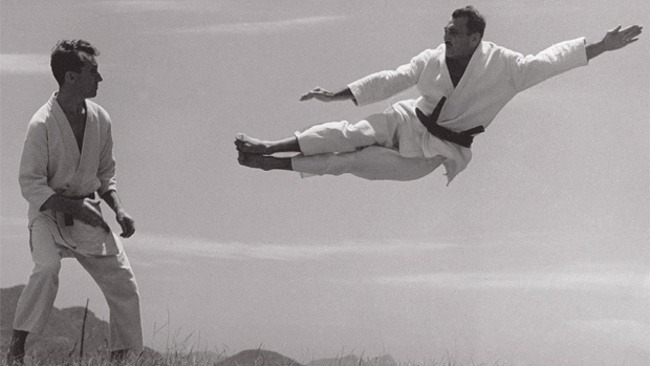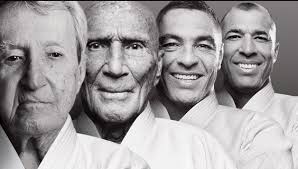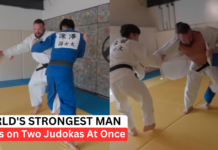
People in grappling like to gossip as much as anyone else. This is not helped by the fact that the history of Brazilian Jiu-Jitsu is plagued with inconsistencies. It is often hard to distinguish fact from fiction which leads people to draw conclusions. As time passes, these conclusions become “fact” although they have no solid base behind them. Some of the most rampant BJJ myths have to do with the founding Gracie family and their history. Today, we bring you 10 little known Jiu-Jitsu Facts about the Gracies and the true history of the Gentle Art.
In some of our past articles, we did our best to explain some of the BJJ idiosyncrasies of today. For example, we went over the history of everyone’s favorite Shaka sign, and the reason it is such a BJJ symbol. On another occasion, we talked about the origins of #Everyday Porrada and explained what “Nutella BJJ” is, as well as the difference between Japanese Traditional Jiu-jitsu and Brazilian Jiu-Jitsu. As much as we take such things for granted, unless we understand exactly what they are all about, we’ll contribute to more and more BJJ myths. Today, the focus is on Gracie history. The 10 Gracie Jiu-Jitsu facts below will definitely clear up some common misconceptions people have about BJJ.
BJJ Myths And Misunderstandings
The moment BJJ became a worldwide phenomenon (arguably right after the first few UFCs) it was bound to result in many myths and obscurities. The Gracies pretty private history didn’t help. The legendary martial arts family did not divulge much apart from what they wanted people to know. Even then, let’s remember that propaganda was an important marketing tool even back then. All the talk of crazy challenges, undefeated champions with hundreds of bouts, etc were a part of the game. It is thanks to those in largely that BJJ managed to get out of Brazil and conquer the world.
However, Facts are facts, and as fun as some things sound, they’re simply not true. Luckily, as a martial art, Brazilian Jiu-Jitsu is built on techniques that are as real as it gets. The efficiency of BJJ is beyond questions. The way it was, and is still being portrayed to the world is not so straightforward though. Which is normal.
If we’re being completely honest, BJJ actually has quite little “mysteries’ compared to other martial arts. This is mostly down the practical nature of the ar and the fact it doesn’t leave too much room for speculation. However, some of the things we take from granted, particularly historically are pretty far from the truth. In that sense, if you’re content with what you know about Jiu-Jitsu, stop reading now. If you do like to clear up some things, we bring you 10 little known Brazilian Jiu-Jitsu facts straight out of the history books.
10 Little Known Gracie Jiu-Jitsu Facts
Enough about myths, let’s talk facts. Thanks to the accounts of people that were present, we can now clear up some key misunderstandings about BJJ. In certain cases, it is family members who focused on doing biographies for Carlos, Helio, Rickson, and other standout grapplers. In other cases, it is people who knew them, worked with or for them. All of them offer their recollections on a bunch of Subjects that people usually get wrong.
Did the Gracies really utterly hate footlocks? Who was the better grappler, Carlos or Helio? Was Helio really a weak and skinny guy with absolutely no strength at all? Who is the man behind the Gracie Diet and is he actually a nutritionist? Time to dwell into the realm of Jiu-Jitsu facts rather than fiction to find the answers to these questions, and a few more.
Who Invented BJJ competition rules?
Many people would really like to know the answer to this one. It is actually not complicated at all. While many think Helio and Carlos came up with BJJ and everything associated, the fact is that what they did is modify at best.
The rules we use in competition today are an evolved version of old Judo rules that the Gracies borrowed, much like with many techniques. Pure grappling bouts before the 1950s were usually decided by these common Judo rules. What the Gracies did is refuse to accept some pinning rules in regard to fighting off the back. n essence, Helio and Carlos actually re-introduced some long forgotten old techniques of grappling. They also modified the rules and adhered to Jigoro Kano’s style of methodical and detailed teaching, which not many people did back then. In fact, Helio often denied that he invented anything.
The Undefeated Gracies
This one is still a hotspot for many discussions today. It is beyond a doubt that the Gracies were tenacious and highly-skilled fighters. They also didn’t shy away from challenges (much) and had the habit of challenging other people often. However, they did not go undefeated for as long as people usually think.
We all know Helio lost to Kimura and a few others. However, that was before he retired from fighting. What actually happened in the period leading up to that is not the supremacy of Jiu-Jitsu over all other martial arts. The Gracies, all of them (yeah including Rickson) both won, lost and drew as part of their fighting record. What the did is introduce a highly unconventional style for the time that gave them a certain edge. However, they did not go undefeated, nor as prolific as many think at any point of their grappling development.

Have you ever heard of the Gracie Hunter? Well, Kazushi Sakuraba certainly deserved that nickname by beating a bunch of the Gracies during the 90s. Check out his winning secrets in the “Kimura Hunter” DVD set. In an instructional like no other, Sakuraba covers everything about his famous Kimura system in four lengthy volumes.
Kimura And Helio Gracie

Another common misconception is that Kimura was so impressed with Helio that he invited him to teach at the Imperial Academy in Japan. All that Kimura did was a comment on Helio’s defensive effectiveness. However, as we all know, Helio was nothing but defensive in that match. Certainly not enough to impress Kimura who had no authority of inviting someone to the emperor’s academy anyway.
Carlos Gracie’s Professional Grappling Career
There wasn’t one. The man that is behind Gracie Barra and modern Brazilian Jiu-Jitsu in general actually never won a professional fight. Carlos Gracie’s only pro fight came in the shape of a bout with a middle-aged wrestling coach. Carlos lost the match by refusing to even step in the ring and fight. All his other exploits were exhibition matches which ended in draws.
Vale Tudo Origins
Similar to Brazilian Jiu-Jitsu, the Gracies are not responsible for the birth or development of Vale Tudo. People were setting up striking vs. grappling matches as early as the late 19th century. In fact, it is mostly down to Brazilian circuses and theaters that put together matchups between different arts, like capoeira and catch wrestling, for example.
Helio Gracie himself has only two Vale Tudo fights, coming out of them with a 1-1 record.
Helio Gracie’s Strength
Speaking of Helio Gracie, what we often imagine when we think of his is a slim and weak Brazilian, weighing barely 140 lbs. It is undisputed that Helio was not a big guy, but he was not a sickly or weak as people thought. He did like to portray himself as such though, raising the stock of Brazilian Jiu-Jitsu along the way. What most people don’t realize is that Helio was a champion swimmer before he took up grappling. As such, he might have been small and an ectomorph by build, but he was by no means weak.
Origins Of the Triangle Choke
Techniques origins are often the main points of dispute in terms of what is real and what is fiction. As far as Jiu-jitsu facts about the triangle choke go, Rorion claims to have introduced it to BJJ. According to him, he discovered it in some old Judo literature and immediately put it to use.
Fact is that the triangle choke was not just in existence, but in use at the time. Even if it was not a usual move, lots of Japanese fighters had tremendous success with it. Back then, most of the Judoka’s that came to Sao Paolo not only knew the triangle but were also teaching it to others.
Gracies Vs. Footlocks?
We all know that footlocks, just like the triangle have their roots in Judo. Well, at least the ones we still like to practice today. After all, Ashi Garamis is a Japanese term regarding a Jud position that allows for foot lock submissions. Back in the early days of Jiu-Jitsu, everyone practiced leg locks just as much as they did other moves. This included the Gracies who had nothing against foot locks.
Another fact is that people thought foot locks were a “cheap” way of winning. Another anecdote might shed some light here. IN a 10 vs 10 challenge between academies, Oswaldo Fadda’s students beat 9 of Gracie’s student by using leg locks. This, in turn, led to the Gracies developing an eversion for the technique.
The Helio Medal Of Honor
This is one of those Jiu-Jitsu facts that are still out there. The fact is that Helio did receive a medal of honor from the Standard Oil Company in 1952. The reason they awarded Helio a medal was that the allegedly saved someone from drowning at great risk to himself. According to a report, helio jumped into shark-infested waters to help save a man that fell from a boat they were in. Whether this was true or just a publicity stunt by Carlos, remains unclear. Given that Helio was a champion swimmer this is not highly believable.
The Gracie Diet

As a source of confusion is perhaps the fact he appeared in several television shows in Brazil, each time called a “dietista”. This prompted many to regard him a nutritionist, which he clearly wasn’t, having only completed primary school education.
Bonus Fact: Gracie Jiu-Jitsu In Street Fights
I know, we said we’d offer 10 Brazilian Jiu-Jitsu facts about the Gracies, but we have a bonus one to offer. This one is pretty close to the “undefeated Gracies” one but form a different perspective. We do know that the Gracies were involved in lots of street fighting during their time.
However, Jiu-Jitsu didn’t seem to be any more effective than other fighting styles in real street fights. In cases of multiple opponents or weapons, the outcome is easy to predict. However, there are no records of the Gracies using BJJ to successfully win a street fight. helio Gracie did, allegedly, pull guard once in a street-fight, and ended up in the hospital.
Final Words
There’s always going to be a lot of speculation surrounding something that’s a global phenomenon. Fact is that we can’t solve every BJJ history puzzle out there. Nor do we want to. Let’s face it, some of these stories sound much better in their publicity version than the original. However, we need to understand that there are Brazilian Jiu-Jitsu facts and Jiu-Jitsu myths. We can enjoy both, as long as we can make the distinction which is which.
Helio Vs. Carlos Gracie – Gracie Jiu-Jitsu History And Politics


![Darce Choke Encyclopedia – Origins, Mechanics and Variations [2025] BJJ, choke, Brabo, BJJ Darce Choke, D'arce Choke, Darce BJJ Choke](https://bjj-world.com/wp-content/uploads/2017/11/JungPoirierLeeYahoo-218x150.jpg)











![Slicin’ Calves Mikey Musumeci DVD Review [2025] Slicin' Calves Mikey Musumeci DVD Review](https://bjj-world.com/wp-content/uploads/2025/04/slicin-calves-mikey-musumeci-dvd-review-218x150.png)
![Jiu-Jitsu For Old Guys Guard Retention Bernardo Faria DVD Review [2025] Jiu-Jitsu For Old Guys Guard Retention Bernardo Faria DVD Review](https://bjj-world.com/wp-content/uploads/2025/03/old-guys-guard-retention-bernardo-faria-dvd-review-218x150.png)
![X-Guard Trickery Kyle Sleeman DVD Review [2025] X-Guard Trickery Kyle Sleeman DVD Review](https://bjj-world.com/wp-content/uploads/2025/03/x-guard-trickery-kyle-sleeman-dvd-review-218x150.png)
![Countering with Crab Ride Anthony Budion DVD Review [2025] Countering with Crab Ride Anthony Budion DVD Review](https://bjj-world.com/wp-content/uploads/2025/03/countering-with-crab-ride-anthony-budion-dvd-review-218x150.png)
![Full Guard Formula James Booth DVD Review [2025] Full Guard Formula James Booth DVD Review](https://bjj-world.com/wp-content/uploads/2025/02/full-guard-formula-james-booth-dvd-review-324x235.png)




![Basic Closed Guard Jasmine Rocha DVD Review [2024] Basic Closed Guard Jasmine Rocha DVD Review](https://bjj-world.com/wp-content/uploads/2024/11/basic-closed-guard-jasmine-rocha-dvd-review-100x70.png)

![Jeff Higgs Self Defense Guard BJJ DVD Review [2024] Jeff Higgs Self Defense Guard BJJ DVD Review](https://bjj-world.com/wp-content/uploads/2024/09/jeff-higgs-self-defense-guard-bjj-dvd-review-100x70.png)
![Effectively Passing The Guard Luke Griffith DVD Review [2025] Effectively Passing The Guard Luke Griffith DVD Review](https://bjj-world.com/wp-content/uploads/2025/01/passing-the-guard-luke-griffith-dvd-review-100x70.png)
![I Got Your Back Jake Straus DVD Review [2025] I Got Your Back Jake Straus DVD Review](https://bjj-world.com/wp-content/uploads/2025/03/i-got-your-back-jake-straus-dvd-review-100x70.png)




![No-Gi Open Guard K-Guard Lachlan Giles DVD Review [2024] No-Gi Open Guard K-Guard Lachlan Giles DVD Review](https://bjj-world.com/wp-content/uploads/2024/12/no-gi-open-guard-k-guard-lachlan-giles-dvd-review-100x70.png)

![Modern Split Squat Passing Jason Rau DVD Review [2024] Modern Split Squat Passing Jason Rau DVD Review](https://bjj-world.com/wp-content/uploads/2024/11/modern-split-squat-passing-jason-rau-dvd-review-100x70.png)


![Simplify the System Side Scissor Brian Glick DVD Review [2024] Simplify the System Side Scissor Brian Glick DVD Review](https://bjj-world.com/wp-content/uploads/2024/09/side-scissor-brian-glick-dvd-review-2024-100x70.png)
![Edging Yourself Out Of Danger Craig Jones DVD Review [2024] Edging Yourself Out Of Danger Craig Jones DVD Review](https://bjj-world.com/wp-content/uploads/2024/12/edging-yourself-out-of-danger-craig-jones-dvd-review-100x70.png)
![Woj Lock the World Chris Wojcik Ankle Locks DVD Review [2024] Woj Lock the World Chris Wojcik Ankle Locks DVD Review](https://bjj-world.com/wp-content/uploads/2024/12/woj-lock-the-world-chris-wojcik-dvd-review-100x70.png)
![Spider and Lasso Guard Jared Welman DVD Review [2025] Spider and Lasso Guard Jared Welman DVD Review](https://bjj-world.com/wp-content/uploads/2025/01/spider-and-lasso-guard-jared-welman-dvd-review-100x70.png)

![Front Head Lock Kaynan Duarte DVD Review [2025] Front Head Lock Kaynan Duarte DVD Review](https://bjj-world.com/wp-content/uploads/2025/02/front-head-lock-kaynan-duarte-dvd-review-100x70.png)


![Leg Locks From Beginner To Advanced Dan Manasoiu DVD Review [2024] Leg Locks From Beginner To Advanced Dan Manasoiu DVD Review](https://bjj-world.com/wp-content/uploads/2024/12/leg-locks-from-beginner-to-advanced-dan-manasoiu-dvd-review-100x70.png)
